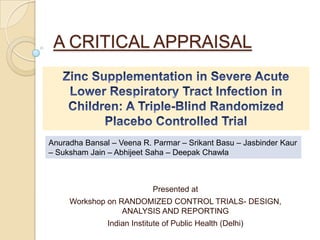
Zinc study
- 1. A CRITICAL APPRAISAL Anuradha Bansal – Veena R. Parmar – Srikant Basu – Jasbinder Kaur – Suksham Jain – Abhijeet Saha – Deepak Chawla Presented at Workshop on RANDOMIZED CONTROL TRIALS- DESIGN, ANALYSIS AND REPORTING Indian Institute of Public Health (Delhi)
- 2. 1. Summary of the article 2. Basic Study Design 3. Section-wise critical appraisal Title and abstract Introduction Material and Methods Results Discussion Conclusion 4. Internal Validity and External Validity
- 3. Objectiv To evaluate the efficacy of zinc supplementation on e duration of illness in children with severe ALRTI Children age group 2-24 months with severe ALRTI (Inclusion P criteria) In a teaching referral hospital in North India 20mg of elemental zinc per day for 5 days I Control group received an equal amount of placebo with C appropriate taste, smell, color and consistency similar to zinc mixture Primary - Time to be asymptomatic (Composite) O Secondary – Duration on hospital stay, Resolution of danger signs, respiratory distress, tachypnea and hypoxia in room air Superiority objective T
- 4. Randomized Control Trial, prospective in nature
- 5. Assessed for eligibility N=120 14 excluded Enrollment (parental refusal or exclusion Process criteria) 106 Randomized 53 - zinc 53 -control Randomization group group 52 - zinc group (1 left against medical 53 received Intervention advice) placebo Follow up 52 analyzed 52 analyzed (1 lost to follow up)
- 6. ITT? The study claims to have followed an intention to treat analysis whereas actually the trial profile shows a minor inconsistency In the intervention arm, one patient left after being randomized – the final result has EXCLUDED the patient and considered n=52 in this arm In the control arm, the loss to follow up has been INCLUDED in the size of the control group as n=53 here. (The n given in the baseline and outcome tables is different)
- 8. TITLE Mentions study design, intervention and population Does not mention the area from which the population has been studied ABSTRACT Objectives, methods, findings and conclusions have been well summarised No mention of the method of randomization INTRODUCTION Justification for the need for study and area mentioned (North India) has been clearly outlined and reflects clinical equipoise
- 10. Method Description Comment RANDOMIZATION Simple Randomization through a random Suspicious as TECHNIQUE number table exactly same size of control and intervention arm has been achieved ALLOCATION Achieved by dispensing the drug and placebo Justified- but no CONCEALMENT in identically looking bottles mention of who dispensed the drug to the patient PREPARATION OF Placebo prepared to give similar taste, smell, Mentioned sources PLACEBO color and consistency compared to original and details zinc mixture BLINDING Repeated mention of the trial being of a No mention of ‘triple blind design’ ‘WHO’ exactly was blinded DISCHARGE Asymptomatic for at least 24 hours. Objective in nature CRITERIA FOR PATIENTS
- 11. SAMPLE SIZE Pilot study revealed that No detailed mention of CALCULATION for 80% power and 0.05 way of arriving at sample two sided alpha, a sample size of 400 was needed which -effect size was brought down to 106 -change in primary due to time constraints outcome SAMPLE SIZE OF THE N=106 Small to give any decisive STUDY Identified by the study as a result, does not resolve limitation the inconsistency of results established by studies before – Precision compromised therefore WIDE CONFIDENCE INTERVAL OBTAINED.
- 12. Time to be asymptomatic Median hours with IQR – range more or less same, statistically insignificant No. of children symptomatic Similar and statistically insignificant value Duration of hospital stay Shorter by 9 hours in the zinc group – result insignificant Time to resolution of respiratory distress, tachypnea, dangers signs and hypoxia Similar in both the groups, results statistically insignificant.
- 13. Sub Group Analysis Post Hoc is questionable, should have been a priori Multiplicity problem Secondary outcomes are correlated Primary and secondary also correlated Duration of stay- degree of subjectivity, not mentioned about blinded also Components of composite endpoint have equal importance in terms of relevance to the patient - more or less the same, least important is duration of stay
- 14. Zinc supplementation did not reduce recovery time and duration of hospital stay Not enough evidence found to reject null hypothesis The conclusions are plausible.
- 15. Internal Validity Selection bias – Doubtful since the number in both the arms has been found to be equal despite simple randomisation Performance bias – Triple blind claimed but no mention of who all were blinded Attrition bias – no problem Detection bias – no mention of who assessed the outcome and who did what? Reporting bias – inconclusive
- 16. External Validity Given the inclusion and exclusion criteria which is generally applicable Inclusion of both wheezy and non wheezy children Very less proportion of population of slum areas, less even in intervention group -Pragmatism? Good proportion of anaemic patients, confounding variable Small sample size
- 17. Group 2 : Dr Sabyasachi Das, Aleesha Mary Joseph, Jalnidh Kaur, Anjali Sinha, Mr Suraj Parab, Dr Sunny Chaudhary, Dr Bhawna Shukla, Dr Rupal Shah
Notas do Editor
- Result – Same proportion of children symptomatic in both group at all time pointsDuration of hospital stay was shorter by 9 hours in the intervention group but statistically insignificantConclusion –
- Not a big loss – both arms Could have imputedReason for loss to follow up not mentioned
- superiority
- Baseline characteristics not balanced, no mention of who dispensed the drug to the patientCallling it as intention to treatP values in baseline characteristicsNot stratified, shudhavminimisedPost hoc subgroup analysis
- HAS REDUCED THE POWER OF THE STUDYCONFIDENCE INTERVAL POSITIVE, SO TREND IS POSITIVE DEFINITELYBASELINE P VALUES – NOT REQUIRED- ATTRIBUTED TO CHANCE
